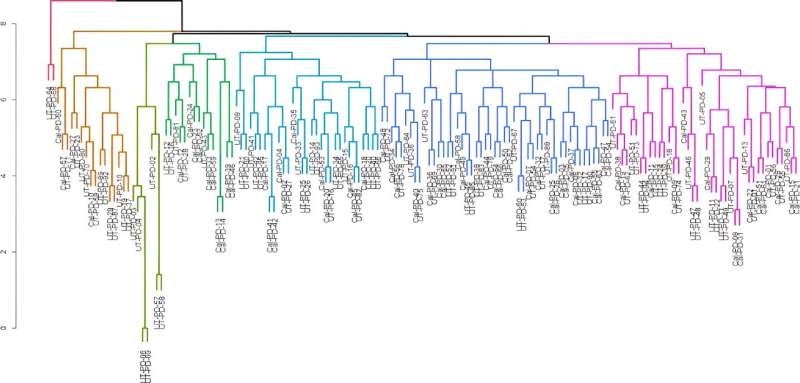Hierarchical clustering of Improving Perennial Plants for Food and Bioenergy (IPPFBE) Foundation and National Plant Germplasm System (NPGS) almond accessions. IPPFBE accessions have the prefix UT-; NPGS accessions have the prefix Cal-. Credit: Journal of the American Society for Horticultural Science (2023). DOI: 10.21273/JASHS05292-23
In the pursuit of enhancing almond genetic diversity for the ever-expanding global demand, researchers have delved into a private almond germplasm collection, shedding light on the potential for new cultivars adapted to diverse growing conditions.
The study, conducted by the United States Department of Agriculture's Agricultural Research Service, National Plant Germplasm System (NPGS), in collaboration with the former Improving Perennial Plants for Food and Bioenergy (IPPFBE) Foundation, explores the genetic diversity of 94 newly available almond accessions, primarily sourced from Central Asian nations.
Almonds [Prunus dulcis (Mill.) D.A. Webb] are perhaps the most economically important member of the genus Prunus L. The edible kernels of almonds have been consumed by humans since at least 11,000 BCE.
With the current worldwide production standing at 4.1 million tons and growing, it is crucial to explore new avenues for almond cultivar development, especially in regions beyond traditional growing areas. Challenges such as limited water resources and climate instability further underscore the need for innovative cultivars, including those adapted to saline conditions.
Plant genetic resources, in the form of germplasm collections, are a valuable component of breeding and cultivar development efforts because they can contain novel superior alleles for existing traits of interest or to address changes in abiotic stressors and pathogens.
The study compared the genetic diversity of the private IPPFBE germplasm collection, which focuses on Central Asian origins, with the existing NPGS collection maintained near Davis, California. Through DNA fingerprinting using 10 simple sequence repeat markers, this research revealed insights into the diversity of these almond accessions.
Hierarchical clustering, principal components analysis (PCA), and discriminant analysis of principal components (DAPC) were employed to analyze and compare the genetic makeup of the collections.
Results indicated that while there are broad similarities between the IPPFBE and NPGS collections, the new material from the private collection significantly contributes to the genetic diversity of almond germplasm. Notably, this work showed close relationships among certain accessions and identified potential mislabeling or duplications. Two Prunus bucharica accessions from the IPPFBE collection stood out, displaying distinctive genetic traits compared to the rest of the collection.
Almonds are an economically important and healthful crop with acreage that is expanding. This expansion encourages the development of new cultivars adapted to new growing areas, and novel germplasm may be the source of alleles needed for adaptation in these locations.
The NPGS and IPPFBE germplasm collections both contain numerous accessions from the almond center of origin. Analysis of the IPPFBE collection indicates that although it and the NPGS collection are broadly similar, the new material contributes positively to the genetic diversity of almond germplasm.
The study is published in the Journal of the American Society for Horticultural Science.
More information: Per McCord et al, Genetic Diversity of New Almond Accessions from Central Asian and Cold-adapted North American Germplasm, Journal of the American Society for Horticultural Science (2023). DOI: 10.21273/JASHS05292-23
Provided by American Society for Horticultural Science
























